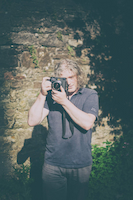The sea stack of Dun Briste on County Mayo's north coast is one of the most spectacular scenes on a spectacular coastline stretching over 2,500km along Ireland's Atlantic seaboard.
Dun Briste or Dún Briste meaning Broken Fort in Irish refers to this small but impressive vertical island on the edge of the Atlantic. In this image, layers of rocks on the stacks exposed sides hint at a sedimentary geological origin.
The sea stack is quite unusual because we are very used to seeing weathered, stump-like remnants that sit much lower than the surrounding mainland with waves topping overin the sea or larger islands with sheep or human habitation. Here we have a continuation on a narrow strip of the mainland with its grass covered plateau at the same height above the sea, precariously perched as if it was formed just yesterday.
Interestingly when an eminent local historian, one of Ireland's best known archaeologists and an ecologist landed on the island in 1981 they were probably the first to set foot on this narrow patch of earth for six hundred years. The annals, a series of written histories recorded by mediaeval monks in Ireland, note an important headland collapsing into the Atlantic in this area in 1393 AD. Irish legend, however, records the headland as being created by St. Patrick, Ireland's patron saint during an epic battle with a wicked man called Crom Dubh.
The archaeologist Seamus Caulfield after reviewing the brief survey he undertook on Dun Briste considered the 1393 date to be more likely as the buildings were of a mediaeval date with a longhouse style of construction being in evidence. The earlier date of the sea stack's formation being from the time of St. Patrick (mid 5th Century) as per legend is thus less likely.
I had spent the morning photographing jewellery for Irish goldsmith Christina Keogh, herself a former archaeologist whose lecturer at UCD was the aforementioned Professor Seamus Caulfield, before heading in the direction of the County Mayo coast for an evening of coastal landscape photography; this was an overdue adventure.
The afternoon was cool and with a beautiful blue sky, reminiscent more of a winter's day but with the day length typical of summer in the northern hemisphere.
After a long journey with a few stop offs for scenes that presented themselves along the way, in a county that I know well, I arrived at the newly created car park for Dun Briste, outside of the town of Ballycastle. Situated on Ireland's Wild Atlantic Way, a 2,500km long defined route along the Atlantic seaboard. The Wild Atlantic Way connects all of the beautiful west coast sections of the country's coastline, not surprisingly Dun Briste is part of this route.
And with good reason, a short but uphill walk from the car park that was manned by a burger van and full of cars; without getting out of breath I was at the edge of the headland looking out towards the Broken Fort of Dun Briste.
The calm conditions continued and despite a little onshore wind there was nothing but me, my tripod and camera situated on the edge of the precipice waiting for just a while until all was right.
After taking my favourite images of the day it was time to really take in the surroundings, fresh air, quietude and the west of Ireland's natural beauty.
At home with a coating of Atlantic scents in my hair and on my clothes it was time to edit the images of the day including those beautiful Christina Keogh Jewellery images from the morning.
But, what a day! You can spend a day with me on my Panoramic Ireland workshops and tours, always experiences on Ireland's Atlantic coast, Northern Ireland's Antrim Coast or along the Liffey in Dublin. Contact me for more information or book via the Photo Workshops option in the top menu, for example the link to my Giant's Causeway experiences here.


Photo of the Day: Dun Briste,Mayo #Ireland by Darren McLoughlin! @travelimages @Failte_Ireland http://t.co/Szm1P98MoW pic.twitter.com/7b4OJfrK5a
— Picture-Ireland.com (@PictureIreland) August 20, 2015

